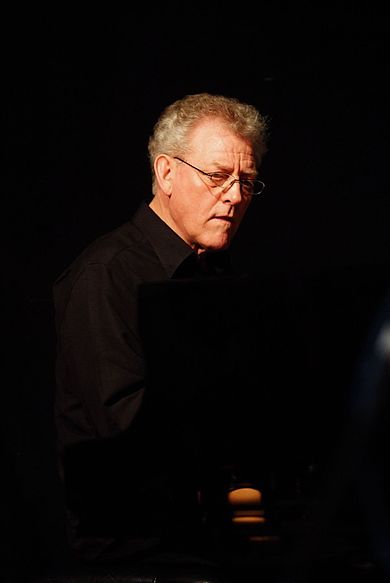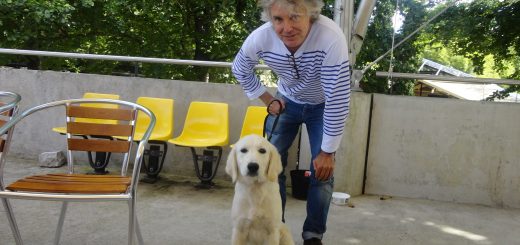JOHN TAYLOR
John Taylor (25 September 1942 – 17 July 2015) was a British jazz pianist born in Manchester; he has occasionally performed on the organ and the synthesiser.
Performing careerEdit
John Taylor first came to the attention of the jazz community in 1969 when he partnered with saxophonists Alan Skidmore andJohn Surman. He was later reunited with Surman in the short-lived group Morning Glory and in the 1980s with Miroslav Vitous‘s quartet.
In the early 1970s, Taylor was accompanist to the singer Cleo Laine and started to compose for his own sextet. He also worked with many visiting artists at Ronnie Scott’s Jazz Club in London, and later became a member of Scott’s quintet.
In 1977 Taylor formed the trio Azimuth, with Norma Winstone and Kenny Wheeler. On some of the group’s recording Taylor played synthesiser and organ. The group was described by Richard Williams as “one of the most imaginatively conceived and delicately balanced contemporary chamber-jazz groups”. The trio made several recordings for ECM Records[1] and performed in Europe, the USA and Canada.
The 1980s saw Taylor working with groups led by Jan Garbarek, Enrico Rava, Gil Evans, Lee Konitz and Charlie Mariano as well as performing in duos with Tony Coe and Steve Arguelles. Composing projects included a commission for the English choir Cantamus Girls Choir with Lee Konitz and Steve Arguelles and pieces for the Hannover Radio Orchestra with Stan Sulzmann. Taylor also performed on David Sylvian‘s song “Laughter and Forgetting”, on which Kenny Wheeler also featured.
As of 2006, Taylor is a member of Kenny Wheeler’s quartet and large ensemble and performs in duo and quartet settings with John Surman; their recording of Ambleside Days on ahum won critical acclaim. In 1996 Taylor played organ on Surman’s choral work Proverbs and Songs from Salisbury Cathedral, later released on ECM Records. During the 1990s he made several recordings also for ECM with Peter Erskine‘s trio with Palle Danielsson on bass.
In 2000 Taylor made a new collaboration with Azimuth and the Smith Quartet for the Weimer Festival. Also in that year he recorded Verso with Maria Pia De Vito and Ralph Towner.
Taylor celebrated his 60th birthday in 2002 with a Contemporary Music Network Tour in which he presented his new trio with drummer Joey Baron and Marc Johnson on bass. The tour also featured the Creative Jazz Orchestra playing Taylor’s composition “The Green Man Suite”. In July 2002 Taylor received the BBC Jazz Award for ‘Best New Work’ for this suite.
Taylor’s trio recording with Johnson and Baron was released early in 2003, and September 2003 saw the release of his solo CD Insight on Sketch. John Fordham wrote in The Guardian: “This is one of contemporary jazz’s great performers at work … a beautiful solo statement by a very modest star.”[2] In 2004 Taylor recorded Where Do We Go from Here? in duo with Kenny Wheeler and Nightfall with bassist Charlie Haden. They subsequently performed at the Montreal International Jazz Festival. Also that year Taylor formed a new trio with Palle Danielsson and Martin France. They performed at the Vancouver Jazz Festival and recorded Angel of the Presence for CAM Jazz. This recording was released in January 2006 to coincide with their UK tour and has received critical acclaim.
Keyboard StyleEdit
Whilst Taylor’s unique piano style draws on the whole of the jazz pallette and considerable influence from classical music, his approach is characterised by a sophisticated and advanced rhythmic and harmonic sensibility. Rhythmically he is a specialist in asymmetrical meters and in employing “drumming” patterns on the keyboard. Harmonically, he has significantly developed and expanded the harmonic vocabulary of musicians such as Bill Evans and Gil Evans[citation needed].
TeachingEdit
Taylor has been professor of Jazz Piano at the Cologne College of Music since 1993, and became a Lecturer in jazz atUniversity of York[3] in 2005. He coaches and teaches undergraduate jazz musicians and is of central importance to the new Master’s degree jazz pathway and in advancing doctoral research and performance in jazz.
FamilyEdit
Taylor was formerly married to jazz vocalist Norma Winstone. Their son Leo Taylor is a drummer who plays with indie rock band The Invisible. He has one other son, singer/songwriter Alex Taylor. He was later married to childhood sweetheart Carol Weston, lasting the rest of his life.
DiscographyEdit
Taylor has made more then 80 LPs and CDs, many for the ECM label.
As leaderEdit
- Pause, and Think Again (1971)
- Decipher (1973)
- Blue Glass (live) (1991)
- Ambleside Days (1992)
- Solo (1992)
- Overnight (2002)
- Rosslyn (2003)
- Songs and Variations (2005)
- Angel of the Presence (2006)
- Whirlpool (2007)
- Requiem for a Dreamer (2011)
- Giulia’s Thursdays (2012)
With Azimuth
- Azimuth (ECM, 1977)
- The Touchstone (ECM, 1978)
- Départ (with Ralph Towner) (ECM, 1979)
- Azimuth ’85 (ECM, 1985)
- How It Was Then… Never Again (ECM, 1994)
As sidemanEdit
With Arild Andersen
- A Molde Concert (ECM, 1981)
With Julian Arguelles
- Phaedrus (1991)
With Peter Erskine and Palle Danielsson
- You Never Know (ECM, 1992)
- Time Being (ECM, 1993)
- As It Is (ECM, 1994)
- Juni (ECM, 1999)
With Mark Feldman
- What Exit (ECM, 2006)
With Jan Garbarek
- Places (ECM, 1977)
- Photo with Blue Sky, White Cloud, Wires, Windows and a Red Roof (ECM, 1978)
With Charlie Haden
- Nightfall (2003)
With Soft Machine
- Land Of Cockayne (EMI, 1981)
With John Surman
- Stranger Than Fiction (ECM, 1993)
- Proverbs and Songs (ECM, 1996)
With Miroslav Vitous
- Journey’s End (ECM, 1982)
With Eric Vloeimans
- Bitches and Fairy Tales (Challenge, 1998)
With Kenny Wheeler
- Double, Double You (ECM, 1984)
- Flutter By, Butterfly (Soul Note, 1987)
- Music for Large and Small Ensembles (ECM, 1990)
- The Widow in the Window (ECM, 1990)
- Kayak (1992)
- Moon (2001)
- What Now? (2004)
- Where Do We Go from Here (2005)
With Marilyn Mazur, Josefine Cronholm & Anders Jormin
- Celestial Circle (ECM, 2011)
ReferencesEdit
- ^ Fordham, John (17 December 2007). “Norma Winstone, Amoroso (Only More So)”. The Guardian. UK. Retrieved18 October 2010.
- ^ Fordham, John (5 September 2003). “John Taylor, Insight”. The Guardian. UK. Retrieved 18 October 2010.
- ^ “John Taylor (Jazz Piano)”. University of York. Retrieved 18 October 2010.
External linksEdit



